No Outlet Stands Out as Most Reliable
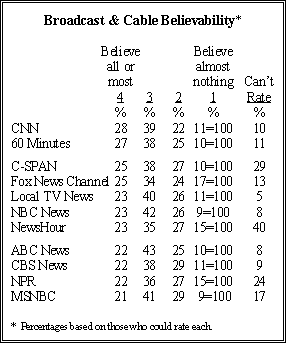 Since the mid-1980s, Americans have become increasingly skeptical of what they see, hear, and read in the media, and almost no major news outlet has escaped this trend. For many media outlets there has been little change in public evaluations in the last four years, but ratings for some continue to inch downward.
Since the mid-1980s, Americans have become increasingly skeptical of what they see, hear, and read in the media, and almost no major news outlet has escaped this trend. For many media outlets there has been little change in public evaluations in the last four years, but ratings for some continue to inch downward.
As a consequence, there is far less variance in public views of the credibility of major news organizations than in the late 1990s. Some of the sources that were viewed as the most credible then have seen their numbers fall substantially, and today no news organization stands out from the crowd as a significantly more reliable source of information.
Changing public views of CNN perhaps best exemplify these trends. In 1998, 42% of those familiar enough with CNN to rate the network said they believed all or most of what CNN reported, significantly more than for any broadcast or cable news outlet tested. Today, just 28% give CNN the highest believability rating, a share which is statistically indistinguishable from most other television news sources.
Other TV news sources, such as 60 Minutes, C-SPAN, and local news stations, have seen similar declines in credibility over the past decade and no longer stand apart as significantly more reliable than other sources.
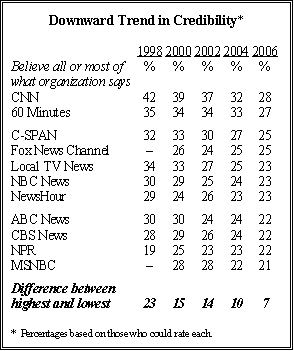 One of the few sources that has not suffered a credibility decline in recent years is Fox News Channel. Currently, one-in-four (25%) say they believe all or most of what they see on Fox News Channel, virtually unchanged since the outlet was first tested in 2000. This overall stability, however, belies the increasingly polarized views of the cable channel. An increasing number of Republicans give Fox News Channel the highest rating for believability, while there has been a comparable decline in ratings among Democrats doubling the partisan gap in views of the network’s credibility between 2004 and 2006.
One of the few sources that has not suffered a credibility decline in recent years is Fox News Channel. Currently, one-in-four (25%) say they believe all or most of what they see on Fox News Channel, virtually unchanged since the outlet was first tested in 2000. This overall stability, however, belies the increasingly polarized views of the cable channel. An increasing number of Republicans give Fox News Channel the highest rating for believability, while there has been a comparable decline in ratings among Democrats doubling the partisan gap in views of the network’s credibility between 2004 and 2006.
Credibility ratings for the three major broadcast networks are comparable currently fewer than a quarter believe all or most of what they see on NBC News (23%), ABC News (22%) or CBS News (22%). As recently as 2000, closer to three-in-ten rated news from these sources as highly credible, though the networks’ ratings have stabilized in the past few years.
It is worth noting that for all major broadcast sources, most Americans generally give positive credibility ratings (a “3” or “4” out of a four-point scale). But the share who say they generally do not believe what they see and hear has grown across the board. On balance, CNN receives more positive than negative ratings by a margin of two-to one (67% vs. 33% among those who gave a rating), but this is down from a nearly five-to-one margin (82% vs 18%) in 1998.
 Print Sources
Print Sources
There is little change in opinions of the credibility of most print news sources compared with two years ago, though as with TV and radio, there has been no recovery from a long, downward trend. Just 19% say they believe all or most of what is printed in their daily newspaper, down from 25% in 2000, but unchanged from 2004. And while the Wall Street Journal remains one of the most believable print outlets, the share who gives it the highest credibility rating fell from 41% in 2000 to 24% in 2004, and stands at 26% today.
The New York Times receives roughly the same credibility rating as other print news sources, but it also has more than its share of strong detractors. While 20% say they believe all or most of what they see in the New York Times, nearly as many (18%) say they believe almost nothing, significantly higher than for other major print news outlets.
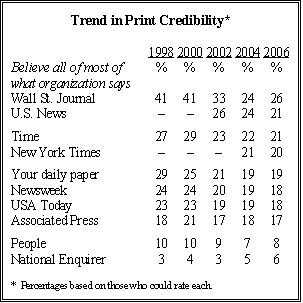 Despite steep declines in credibility for such sources as CNN and local news, television sources continue to be rated somewhat higher for credibility than print news sources. Seven of the 10 television news sources tested are rated as highly credible by 23% or more who rate them. By comparison, seven of the eight print news sources tested receive the highest marks for credibility by 21% or fewer who offer ratings.
Despite steep declines in credibility for such sources as CNN and local news, television sources continue to be rated somewhat higher for credibility than print news sources. Seven of the 10 television news sources tested are rated as highly credible by 23% or more who rate them. By comparison, seven of the eight print news sources tested receive the highest marks for credibility by 21% or fewer who offer ratings.
Partisanship Evident
Republicans express less confidence than Democrats in the credibility of nearly every major news outlet, with the exception of Fox News Channel. Among TV and radio sources, the partisan gap is particularly evident for the NewsHour with Jim Lehrer and NPR Democrats are twice as likely as Republicans to say they believe all or most of what these outlets report, placing them among the most credible sources for Democrats, and among the least credible for Republicans.
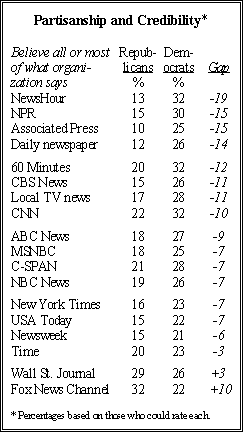 At the other end of the spectrum is Fox News Channel, which receives the highest credibility rating among Republicans and one of the lowest ratings among Democrats. Nearly a third of Republicans (32%) rate Fox News Channel as highly credible, far more than say the same about its major competitors CNN (22%) or MSNBC (18%). For Democrats, the believability of cable news sources is virtually the reverse just 22% believe all or most of what they see on Fox, compared with 25% for MSNBC and 32% for CNN.
At the other end of the spectrum is Fox News Channel, which receives the highest credibility rating among Republicans and one of the lowest ratings among Democrats. Nearly a third of Republicans (32%) rate Fox News Channel as highly credible, far more than say the same about its major competitors CNN (22%) or MSNBC (18%). For Democrats, the believability of cable news sources is virtually the reverse just 22% believe all or most of what they see on Fox, compared with 25% for MSNBC and 32% for CNN.
Party differences also are substantial for daily newspapers as well as for the Associated Press a major provider of newspaper content. Just 10% of Republicans who could rate the AP said they believe all or most of what the wire service reports, compared with 25% of Democrats. Similarly, 12% of Republicans give their daily newspaper the highest rating for credibility, compared with 26% of Democrats.
Democrats More Skeptical
Despite the substantial partisan differences in credibility ratings, the gap has narrowed since 2004 for many major outlets. This has occurred largely because Democrats see many news sources as less credible now than they did two years ago, including CNN, the major television networks, and the New York Times. At the same time, the credibility of nearly all of the sources remained statistically unchanged for Republicans.
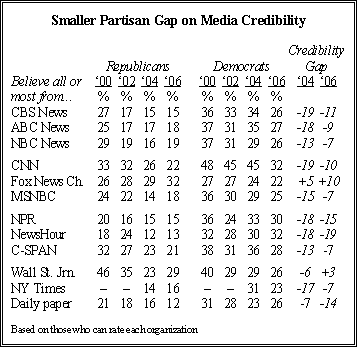 In 2004, 45% of Democrats gave CNN the highest ratings for credibility, compared with 26% of Republicans. There has been a 13-percentage point drop in views of CNN’s credibility among Democrats in the past two years, significantly shrinking the difference in opinion across party lines. The same is true for both CBS News and ABC News, which Democrats rate eight percentage points lower today than in 2004; again, Republican views have remained largely unchanged. And currently just 23% of Democrats give the New York Times the highest believability rating, down from 31% in 2004.
In 2004, 45% of Democrats gave CNN the highest ratings for credibility, compared with 26% of Republicans. There has been a 13-percentage point drop in views of CNN’s credibility among Democrats in the past two years, significantly shrinking the difference in opinion across party lines. The same is true for both CBS News and ABC News, which Democrats rate eight percentage points lower today than in 2004; again, Republican views have remained largely unchanged. And currently just 23% of Democrats give the New York Times the highest believability rating, down from 31% in 2004.


